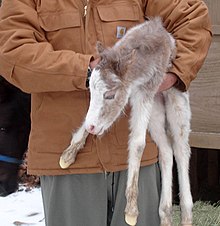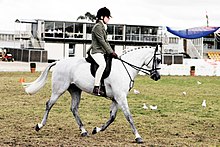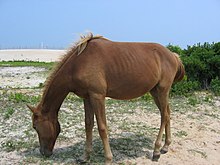
The horse is a domesticated, one-toed, hoofed mammal. It belongs to the taxonomic family Equidae and is one of two extant subspecies of Equus ferus. The horse has evolved over the past 45 to 55 million years from a small multi-toed creature, close to Eohippus, into the large, single-toed animal of today. Humans began domesticating horses around 4000 BCE, and their domestication is believed to have been widespread by 3000 BCE. Horses in the subspecies caballus are domesticated, although some domesticated populations live in the wild as feral horses. These feral populations are not true wild horses, which are horses that never have been domesticated and historically linked to the megafauna category of species. There is an extensive, specialized vocabulary used to describe equine-related concepts, covering everything from anatomy to life stages, size, colors, markings, breeds, locomotion, and behavior.
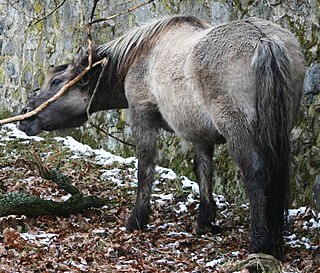
How and when horses became domesticated has been disputed. Although horses appeared in Paleolithic cave art as early as 30,000 BC, these were wild horses and were probably hunted for meat. The clearest evidence of early use of the horse as a means of transport is from chariot burials dated c. 2000 BC. However, an increasing amount of evidence began to support the hypothesis that horses were domesticated in the Eurasian Steppes in approximately 3500 BC. Discoveries in the context of the Botai culture had suggested that Botai settlements in the Akmola Province of Kazakhstan are the location of the earliest domestication of the horse. Warmouth et al. (2012) pointed to horses having been domesticated around 3000 BC in what is now Ukraine and Western Kazakhstan.
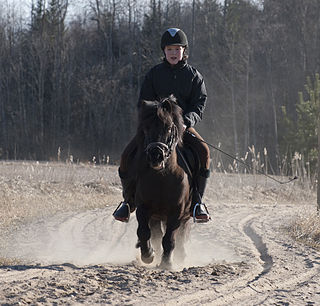
The Shetland pony is a Scottish breed of pony originating in the Shetland Islands in the north of Scotland. It may stand up to 107 cm (42 in) at the withers. It has a heavy coat and short legs, is strong for its size, and is used for riding, driving, and pack purposes.

A draft horse (US) or draught horse (UK), also known as dray horse, carthorse, work horse or heavy horse, is a large horse bred to be a working animal hauling freight and doing heavy agricultural tasks such as plowing. There are a number of breeds, with varying characteristics, but all share common traits of strength, patience, and a docile temperament.

Withers are the ridge between the shoulder blades of an animal, typically a quadruped. In many species, this ridge is the tallest point of the body. In horses and dogs, it is the standard place to measure the animal's height. In contrast, cattle are often measured to the top of the hips.

The Gypsy Cob, also known as the Traditional Gypsy Cob, Irish Cob, Romani Cob, Gypsy Horse, or Gypsy Vanner, is a breed of domestic horse from the British Isles. It is a small, solidly-built horse of cob conformation and is usually piebald. It is associated with Irish Travellers and English Romanichal Travellers. There was no stud-book or breed registry for these horses until 1996, but as breeders developed standards and recorded pedigrees, there are now organizations that register qualifying horses..

The Highland Pony is a native Scottish pony, and is one of the largest of the mountain and moorland pony breeds of the British Isles. Its pedigree dates back to the 1880s. It was once a workhorse in the Scottish mainland and islands, but today is used for driving, trekking and general riding. They are hardy and tough, they rarely require shoeing, and are economical to keep.
Riding pony is a horse show classification used to refer to certain types of ponies. Competition is divided into sections based on height and type, and include being judged under saddle in standard pleasure horse classes, as well as in related events such as sidesaddle or in-hand.
The Welara is a part-Arabian pony breed developed from the Arabian horse and the Welsh pony. It was originally bred in England by Lady Wentworth at the Crabbet Arabian Stud in the early 1900s from imported Arabian stallions and Welsh pony mares. Breeding then spread throughout North America. In 1981, a breed registry was formed in the United States, and a studbook began to be published. They are used for many disciplines of English riding, and are known for their refinement, hardiness and spirit.
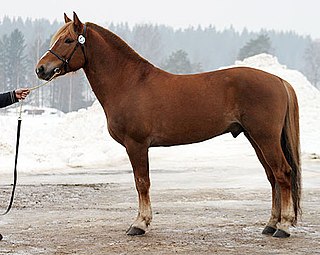
The Finnhorse or Finnish Horse is a horse breed with both riding horse and draught horse influences and characteristics, and is the only breed developed fully in Finland. In English it is sometimes called the Finnish Universal, as the Finns consider the breed capable of fulfilling all of Finland's horse needs, including agricultural and forestry work, harness racing, and riding. In 2007, the breed was declared the official national horse breed of Finland.
The Lokai, a mountain horse bred in Tajikistan, is used as a riding horse, a packhorse, or even sometimes a light draft horse. Although small, the breed is agile and hardy. The breed was developed by crossing native mountain horses with a mixture of Central Asian and European bloodlines.

A cob is traditionally a draft type pony. Typically of a stout build, with strong bones, large joints, and steady disposition, it is a body type of horse rather than a specific breed. Historically, in the United Kingdom and, to a lesser extent, the eastern United States, a 'cob' may be a common horse used for everyday riding but in the past was used for driving carts.

The Australian Riding Pony is a breed of pony developed in Australia since the 1970s. It has been greatly influenced by the British Riding Pony, the Thoroughbred and Arabian bloodlines.

The Bardigiano is a breed of small horse from the Emilia Romagna region of Italy. It takes its name from the town of Bardi, in the Apennines of Parma, and is principally associated with the surrounding area and the Valle del Ceno. The mountain environment and steep, rough terrain of the area have contributed to produce a robust, hardy breed, agile and sure-footed over difficult ground. Although some males and all females are under 14.2 hands, the Bardigiano is always considered a horse in its home country. The stud book was established in 1977, and is held by the Associazione Provinciale Allevatori, the regional animal breeders' association, of Parma. The breed is widely distributed in Italy, with breeders in 26 Italian provinces; a recent study examined 3556 stud book entries for living horses. Due to these relatively large numbers, the breed is not considered to be at risk of extinction, but is classed as "vulnerable".

The show hack is a type of ridden show horse, exhibited to a standard first established in England.

Mountain and moorland ponies form a group of several breeds of ponies and small horses native to the British Isles. Many of these breeds are derived from semi-feral ponies kept on moorland or heathland, and some of them still live in this way, as well as being kept as fully domesticated horses for riding, driving, and other draught work, or for horse showing.

The Heck horse is a horse breed that is claimed to resemble the tarpan, an extinct wild equine. The breed was created by the German zoologist brothers Heinz Heck and Lutz Heck in an attempt to breed back the tarpan. Although unsuccessful at creating a genetic copy of the extinct species, they developed a breed with grullo coloration and primitive markings. Heck horses were subsequently exported to the United States, where a breed association was created in the 1960s.
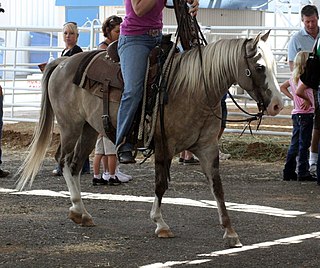
The Quarter Pony is a breed of pony that is similar to the American Quarter Horse. It stands up to 14.2 hands high and was developed from American Quarter Horse foundation bloodstock. The breed was originally developed from Quarter Horses that did not meet the American Quarter Horse Association's height requirement. It is bred to look like a small Quarter Horse, although the various registries also allow crosses with other breeds, including Paint horse, Appaloosa and Pony of the Americas, all stock types. It is one of the most versatile horse breeds there are. There are three registries for the Quarter Pony, all with slightly different registration requirements. The first registry was begun in 1964, and two more were started in the 1970s. The breed is used today in a variety of Western and English riding disciplines.

This is a basic glossary of equestrian terms that includes both technical terminology and jargon developed over the centuries for horses and other equidae, as well as various horse-related concepts. Where noted, some terms are used only in American English (US), only in British English (UK), or are regional to a particular part of the world, such as Australia (AU).


